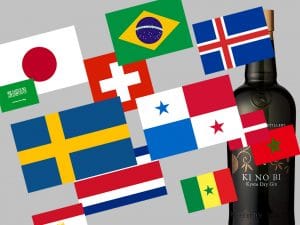Group A
 |
RussiaVeresk Gin— I covered Versek in my book, but Summer Fruit Cup also has a solid review of it online. |
 |
Saudi ArabiaAlcohol is illegal in Saudi Arabia; therefore their world cup journey is going to come to an end in the group stage. |
 |
UruguayI haven’t had a Uruguayan gin, but South America has some really solid gins. And there is a go-to place for G&T’s in Montevideo. Point for the 1930 winners here. But only a few of the country’s many wineries distill— and most that do, do so only for the local market. |
 |
EgyptButler’s Gin is a London Dry style Gin produced by the United Distillery Group/Al Ahram Beverages Group. |
The host nation is given a gift here. In what is by far the easiest group in the Gin World Cup, the Russians easily advance. The group’s runner up is a bit harder to pick. While Uruguay has a stronger culture of spirits production, it’s the Egyptian distilled Butler’s Gin [though under license from a UK group] that seems to have the higher reputation.
Group A Winner: Russia
Group A runner up: Egypt
Group B
 |
PortugalThe nation has a long and storied history of gin production. Although none of them rise up to Cristiano Ronaldo level, gin drinkers have been swooning over Sharish Blue Magic Gin. It turns pink when mixed with tonic. With a strong history and lots of solid gins, Portugal is a strong candidate to emerge from its group. |
 |
SpainNot only has Spain given us the Gin Tonica— it’s given us some of the boldest and most striking contemporary gins of the last five years. For something classic try Master’s London Dry. |
 |
MoroccoMorocco is one of the world’s largest suppliers of coriander, so although Morocco doesn’t have much in the way of local gins— they do contribute to the success of hundreds of gins distilled around the world. |
 |
IranAnother nation where liquor is illegal. Though apparently a thriving black market exists, it’s not enough to help Iran get out of the group stage. |
The Iberian peninsula is a bonafide gin and spirits powerhouse. Spain’s selection of eclectic gins gets them the win, but their contributions to gin and tonic drinking culture make them one of the tournament’s early favorites. Portugal advances easily after wins against Morocco and Iran.
Group B Winner: Spain
Group B Runner Up: Portugal
Group C (the group of death)
 |
FranceFrance is home to some really fantastic gins. Whether G’vine’s Floraison incorporating elements of the local viniculture tradition; or Citadelle being distilled on spare time on Cognac stills— France is a gin powerhouse. |
 |
AustraliaNo region has introduced the gin-drinking world to as many novel botanicals that work well in gin as Australia has. From the wonderful, classic, above Navy Strength Old Young’s Common Gin to the celebration of Australian flora that is Botanic Australis— Australia is one of the strongest nations in the tournament. |
 |
PeruThe Inca Distillery makes a line of quite nice gins using cane spirit; however, the real star here is the excellent London to Lima Gin. It just be the Lionel Messi of this gin world cup. |
 |
DenmarkDenmark has a thriving gin culture, which is well chronicled by Danish gin writer En Verden Af Gin. ELG Gin, Njord Gin, Herbie Gin and Copenhagen Gin— just to name a few. While harder for us to get, especially stateside, those in Denmark have a ton of great local gins to choose from. |
Groups C is indeed the Gin World Cup’s group of death. All four countries have star players. Australia may have the deepest roster, France has the most star studded; but Peru might have the best player in the entire group. In any other division Denmark would have been a legitimate threat to advance. Here, they would be lucky to pull out a single point.
Group C Winner: Australia
Group C Runner-up: France
Group D
 |
ArgentinaA one-star roster (like the real Argentinian world cup team?) led by Principe de los Apostoles Mate Gin. |
 |
CroatiaMaster of Malt highlights some of the best of Croatian gin culture with their Origin Series. What does Juniper from Klanac taste like? Or how about Mazin? But Croatia has a strong gin culture aside. There’s the color changing 5 Corners Gin, the Dubrovnik based Luftbremzer Gin and the best selling Sax Gin. |
 |
IcelandThe nation of only 300,000 is a surprise world cup qualifier; however, in terms of gin world cup qualification— Iceland is far from a surprise. Einberja, Ísafold Gin, and Vor’s barrel aged and regular gins highlight a strong showing from a country where everything but Brennevin was illegal just a generation ago. |
 |
NigeriaThe Nigerian team fielded an illegal player and were disqualified from competition. |
While Iceland ran away with group D on the strength of the one-two punch of Vor and Vor— Croatia and Argentina engaged in a closely fought battle for second, with the South American side advancing by a hair.
Group C Winner: Iceland
Group C Runner-up: Argentina
Group E
 |
BrazilA large nation that saw the opening of its first craft gin distillery in just 2016. Amazzoni Gin leads the way, for a nation just finding its footing. |
 |
SwitzerlandSwitzerland might have an easy go of Group E. Ulrich’s line of nginious! gins aren’t only one of the most obvious puns on the gin market today, nginious! Smoked & Salted Gin is one of the most surprisingly excellent gins that I didn’t know I needed in my life. |
 |
Costa RicaWhile there’s plenty of beaches in Costa Rica to enjoy a G&T on; this is a nation better known for its rum. |
 |
SerbiaMajdanpek grows some wonderful juniper, and the Majdanpek Origin Gin is a great example of terroir in gin. |
Group E Winner: Switzerland
Group E Runner Up: Brazil
Group F
 |
GermanyIf Germany doesn’t make it out of the group stage, the Monkey 47 fan group will surely riot. But Germany has a deep lineup and is stacked at every position. From Lyonel Dry Gin to Ferdinand’s Saar Quince Gin— Germany is as deep as it is delicious. |
 |
MexicoMexico has a burgeoning gin scene, with several local distilleries getting into the game. My favorite is the mezcal kissed Pierdas Almas +9 Botanicals. Albeit expensive, it’s unique and delicious. |
 |
SwedenSweden might have one of the biggest stars of the tournament. The Herno Distillery alone has at least five players in the lineup and they’re all excellent. The juniper cask gin is perhaps their best and most creative. But Gothenburg Gin and Spirit of Hven Gin and even Nils Oscar Tärnö Gin make this a nation to be reckoned with. |
 |
South KoreaPerhaps a bit more into their Soju than gin, the Koreans don’t yet have a gin roster capable of making it out of the group stage. |
Group F Winner: Sweden
Group F Runner up: Germany
Group G
 |
BelgiumBelgium is home to several protected types of genever which can only be made in Belgium. But it also is home to some several really worthwhile gins. Try Diep 9 Old Genever, Filliers Oude Graanjenever or one of my personal favorites— Fillier’s Pine Blossom Gin. |
 |
PanamaPanama sure likes drinking their gin, but in terms of distilling, Panama is a rum country through and through. |
 |
TunisiaThey have their Boukha, but no much in terms of gin. |
 |
EnglandEven if you exclude the gins that were once distilled in London and are now technically distilled in Scotland— England has the deepest gin roster of the tournament. The starting 11 could include, Cotswolds Dry Gin, Beefeater, and a whole midfield distilled by East London Liquor Company. England’s place in gin history is clear— can they win the tournament again? |
England looks to runs away with the group, starting a different 11 gins in each of their three qualifying games. But in the final game Belgium’s historical prowess meets England’s historical prowess and they play to a draw.
Group G Winner: England
Group G Runner-up: Belgium
Group H
|
|
PolandPoland’s Lubuski Gin is the most recommended Polish gin brand. The nation’s first love may well be vodka. |
 |
SenegalSenegal isn’t known for their gin production, though gin and tonics are available. It’s not a total wash. |
 |
ColombiaIn last year’s tournament Colombia was out at the group stage as a traditional rum powerhouse; but Dictador’s Ortodoxy and Treasure give Colombia a powerful duo of gin interpreted through a rum distiller’s lens. |
 |
JapanSimilar to group H colleague Colombia, Japan wouldn’t have gone far in last year’s world cup. But this time several Japanese distillers have gotten into the game— Japan might have the most exciting young lineup in the entire tournament: Roku, Nikka Coffey Gin, and Ki No Bi head up this year’s lineup. |
Group H proves to be the most exciting in terms of gin’s future. Two countries who’ve never made it past the group stage do so this year on the strength of young talent.
Group H Winner: Japan
Group H Runner Up: Colombia


